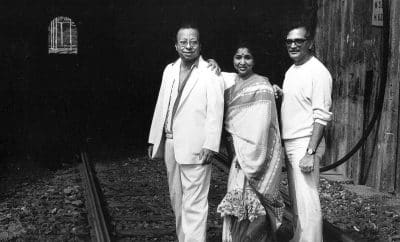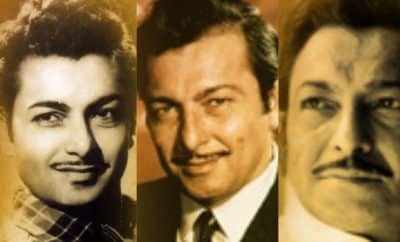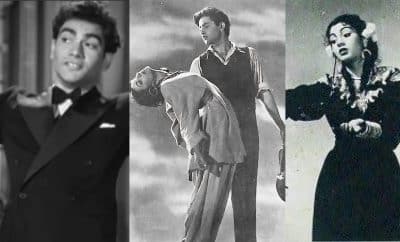Collections
Smita Patil – Prolific Presence that Filled the Screen
Countless actors – some with unique style, some with good comic timing, some with great dancing skills and some with emotive acting – have enriched Hindi cinema since its inception. However, there were very few, who were a complete package of acting – so much so that their mere presence without even a single line to deliver filled the entire frame.
She was a part of that gifted lot. Starting as a television newsreader in the early 1970s on Mumbai Doordarshan, she soon proved her mettle and in almost no time became a leading actor in parallel cinema. Within just three years of her debut, she won the National Film Award for best actress. She came, she acted, and she just conquered!
She was so committed to parallel cinema that she denied big offers for commercial films. However, with changing times, the dynamics of parallel cinema also changed, and the filmmakers started looking for popular faces. She was unceremoniously dropped from a few projects despite her proven acumen. This came as a big revelation, and she then decided to explore the paths of commercial cinema that she had been avoiding before. She had a successful commercial stint too, while simultaneously showing up in parallel cinema, albeit less frequently than before. Her glamorous roles in the commercial films proved that commercial cinema and parallel cinema are not mutually exclusive, and one could be equally excellent in both simultaneously. Nevertheless, she was reportedly not very happy with the rain dances and love scenes that she was required to perform in the commercial films.
Yes, she is one and only Smita Patil, one of the greatest film actors of all the times! Born in Pune on 17 October 1955 to Shivajirao and Vidyatai Patil, a Maharashtrian politician and a social worker respectively, she had a flair for acting right from her childhood. She started her film career with Teevra Madhyam (an FTII student film by Arun Khopkar) and Charandas Chor (1974), a children’s film by Shyam Benegal. Her first major role was in Manthan (1976), wherein she played a Harijan woman leading the revolt of a milk co-operative. She rose to the zenith of career through the remarkable roles in the films Bhumika (1977), Gaman (1978), Chakra (1981), Bazar (1982), Arth (1982), Mandi (1983), and Mirch Masala (1987). The commercial films with her notable roles include Namak Halal (1982), Shakti (1982), Aakhir Kyon? (1985), and Waaris (1988).
Besides being an accomplished actor, she was also an active feminist deeply committed to the advancement of women and a member of Women’s Centre in Mumbai. This often reflected in her roles representing intelligent femininity that stood in relief against conventional male dominated background.
Barely a decade from the outset of her film career, and she breathed her last just at the age of 31 due to childbirth complications, leaving all her fans in a shock and sorrow. The child, none other than Prateik Babbar, also went on to become a well-known face in Hindi cinema. Nonetheless, for him too, his mother perhaps remains as much an unseen legend that once lived, as she is for anyone else.
In a span of a decade, she left an indelible imprint through her proficient acting. She did not need any dramatic dialogues or lines to mime to make her presence felt, she did it just through her astounding body language and expressive eyes. Remember the Sonbai facing the arrogant Subedar with an astonishing aplomb in Mirch Masala; or a determined yet affectionate superintendent of a women’s reformatory, Sulabha Mahajan, in Umbartha / Subah; or the feisty and revolting Bindu in Manthan?
She received several National and State Film Awards and Filmfare Awards during her career. She was also honoured with India’s fourth highest civilian honour Padma Shri in 1985.
The majority of the 80 odd films that she appeared in during her career were Hindi films. She also acted in Marathi, Bengali, Gujrathi, Malayalam, and Kannada films. Although her Marathi films were just a handful, most of her Marathi roles are counted amongst her best performances. Her notable Marathi films are Samna (1975), Jait Re Jait (1977), Sarvasakshi (1978), and Umbartha (1982).
Let us look at a few of her Marathi songs, which are representative of her acting skills.
1. Jaambhul Piklya Zhaadaakhali (Jait Re Jait – 1977)
Jait Re Jait (Win, Win) is an art film produced by Hridaynath Mangeshkar and Usha Mangeshkar and directed by Dr. Jabbar Patel, which narrates a paradoxical story of winning in life but losing the love. The film was based on a novel by the same name by the veteran Marathi writer, freedom fighter and historian G.N. Dandekar (the maternal grandfather of the Marathi actress Mrunal Kulkarni).
Smita Patil plays the female lead Chindhi, an outspoken and courageous tribal woman, who is unhappy with her marriage. She falls in love with a young man from her tribe Nagya (Dr. Mohan Agashe), who is a dashing drummer.
The song “Jaambhul piklya zhaadaakhaali dhol kunaacha waaja ji?” (The sound of the drum being played under the Jamun tree is driving me crazy), playing in the background with the side actors lip-syncing it, shows Chindhi’s frustration about her dead marriage and her unabashed expression of attraction towards Nagya. Smita Patil effectively portrays both these feelings simultaneously through her body language and gestures.
Hridaynath Mangeshkar has set N.D. Mahanor’s rustic words to a befitting folksy tune, rendered exuberantly by Asha Bhosle and Ravindra Sathe.
https://www.youtube.com/watch?v=Tyb2dPv4jTg
The film earned Dr. Patel and Smita Patil Filmfare Awards. In addition, Dr. Patel got the Maharashtra State Film Award for the best director. The film also won President’s Silver Medal for Best Feature Film in Marathi.
2. Mi Raat Taakli (Jait Re Jait – 1977)
Chindhi, despite a lot of criticism and resistance from her family and community, finally decides to break the ties of her dead marriage to enter into a relationship with Nagya. The song “Mi raat taakli, mi kaat taakli” (I have let go of the last night and moulted the old skin) shows this liberation in love.
Smita Patil is seen walking freely through the jungle, and again through her walk and the gestures, she perfectly expresses her liberated mind and happiness.
The mesmerising words of N.D. Mahanor are composed by Hridaynath Mangeshkar in an equally haunting tune supported by a host of conventional as well as unconventional instruments like sundari, clarinet, toto, santoor, ghungroo tarang, Spanish guitar, dhol, duff, bagalbachcha and Rajasthani shehnai. The song is rendered by Lata Mangeshkar in a sweet and gleeful voice. She is the perfect choice for expressing Chindhi’s joy outlined by her determination.
3. Sunya Sunya Maifilit Maazhya (Umbartha – 1982)
Umbartha (the doorstep), directed by Dr. Jabbar Patel, portrays the ironical story of a woman’s dream to step outside the four walls of her home and bring change in the society. Smita Patil plays the lead role of Sulabha Mahajan, who steps out to work as a superintendent of a women’s reformatory with ambition and determination, only to realise very soon the dirty realities of the so-called noble activities actually driven by the hidden agendas of a few influential people. While she is coping up with this, a big revelation hits her that her family including her only daughter has gone far away from her emotionally, in her attempt to fulfil her idealistic ambition, which already seems somewhat futile. The film was simultaneously made in Hindi as Subah with the same cast.
The song “Sunya sunya maifilit maazhya tuzhech mi geet gaat aahe” (In the deep void of my heart, I cherish your memories through your song) shows her agony and sorrow. The lyrics have flown from the copious pen of the Marathi poet Suresh Bhat well known for his Ghazals. Hridaynath Mangeshkar’s pathos laden composition is orchestrated mainly with violins and sitar. Lata Mangeshkar’s soulful rendition pulls on our heartstrings. Smita Patil was present at the recording of the song and was in tears after she heard Lata Mangeshkar sing it.
The song plays in the background and Smita Patil brilliantly brings to life each and every line through her adept gestures. In an interview, Dr. Jabbar Patel has mentioned that Smita Patil hardly needed any direction and most of her nuanced expressions in this song are spontaneous.
There is an interesting and well-known anecdote about the song. The song was originally written for a Marathi movie which was proposed to be produced by Jayashree Gadkar based on Amrutvel, a novel by the veteran Marathi novelist V.S. Khandekar. Suresh Bhat was called to write the songs and put up in a hotel in Mumbai. However, he suddenly ended up in a writer’s block and could not write a single word even after many days. As the cost of the hotel was increasing without any output from Suresh Bhat, he had to leave. While he was waiting for a taxi in the hotel lobby, he got a creative impulse at once and wrote this song on a piece of paper in just a few minutes! Unfortunately, the film was shelved and the song that was written so dramatically did not see the light of the day then. It was later used in Umbartha.
The film got the National Film Award for Best Feature Film in Marathi and Maharashtra State Film Award for best film. It also fetched Dr. Jabbar Patel and Smita Patil the State Film Awards for the best director and the best actor respectively.




Virender Gupta
October 17, 2023 at 1:56 pm
Very nicely compiled